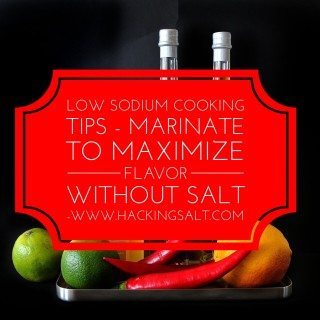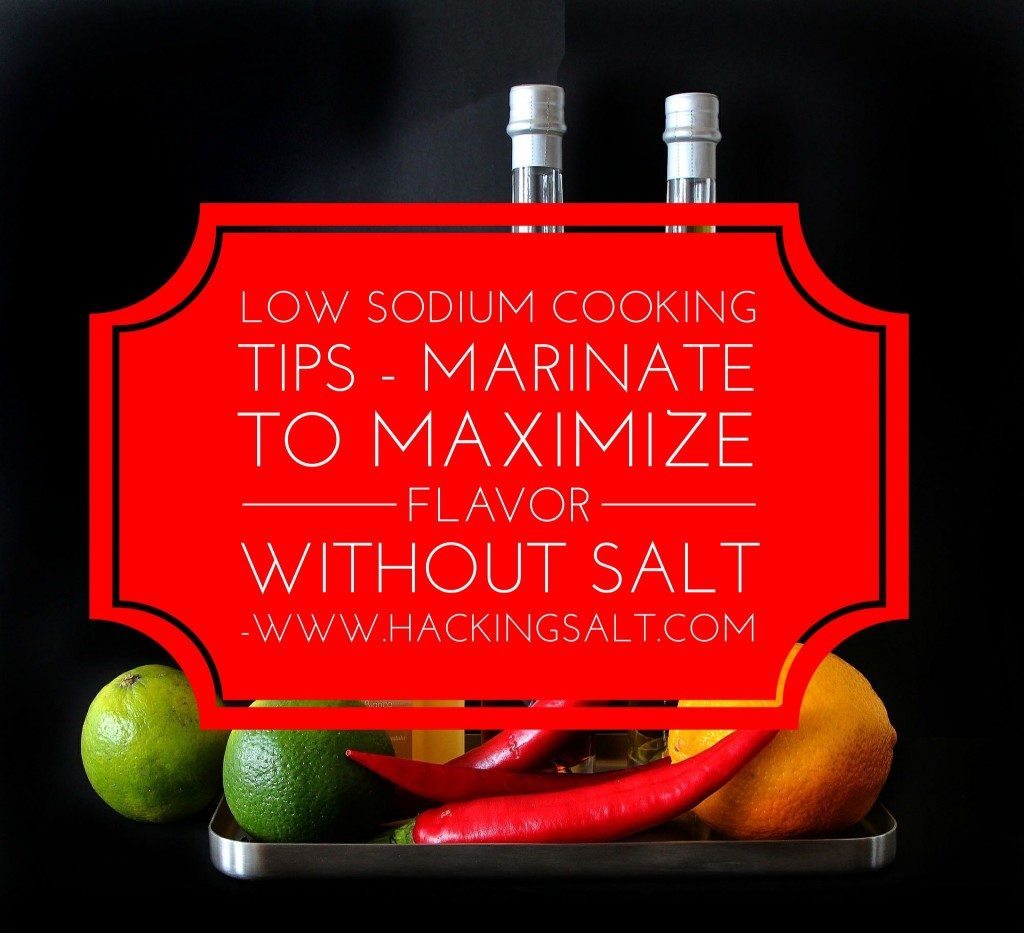Low Sodium Cooking Tips – Marinate to Maximize Flavor Without Salt
When I talk to someone, or encounter someone who is just finding out about the low sodium lifestyle, I usually hear two things from them right off the bat. The first is that;”all my food will be bland!” Hopefully if you’ve followed my blog or tried any of the recipes, you know that isn’t true. The second thing I always hear is; “I can’t cook!” Well OK then! Now I have something to work with. It is true that you can truly remove almost all of the sodium you need to if you can cook at home, and mostly from scratch. You can also add great flavors if you know a few techniques to help you as a cook.
In today’s post, we will talk about tenderizing and flavoring proteins (meat, poultry, and seafood). Historically, salt has been used as a tenderizer, and when added to water and other spices it becomes a brine. The salt helps to break down the tissue, and it also interacts with the tissue, just like salt does in our bodies, to hold water in the tissue. These are great ways to prepare our proteins, but the end result adds way too much sodium to our dish, and thus it becomes unhealthy.
The better way to go is to use a marinade. Marination is the process of soaking foods in a seasoned, often acidic, liquid before cooking. We are looking to add flavor to the proteins we are about to eat by adding flavor through the immersion in liquid (similar to how brine works, and pickling, but without the salt. In order to achieve the same effects of tenderization and imbuing flavor that salt does in a brine, we need a liquid that is either acidic or enzymatic.
Acidic Marinades typically fall into three categories:
Vinegars:
- Balsamic
- White
- Malt
- Cider
- Wine
- Rice
- Cane
- Beer
- Coconut
Citrus Juice:
- Lemon
- Lime
- Orange (Sour, Blood, etc.)
- Tangerine
- Citron
- Buddha’s Hand
- Grapefruit (Not appropriate for transplant/heart patients due to drug interactions)
- Calamansi
- Kumquat
- Pomelo
- Rangpur
- Ugli fruit
- Yuzu
Wines:
Too many varieties to list out. Different ones will flavor differently, based on lightness, sweetness, dryness, etc. of the flavor profile.
Enzymatic Liquids are juices from fruits that contain high enzyme levels such as:
- Pineapple
- Kiwi fruit
- Papaya
Herbs & Spices
In addition to the liquid above, the other components of a marinade are an oil, and herbs and spices. The purpose of marinating is to break down the tissues of the protein we are preparing. In meats, the acid causes the tissue to break down, which allows more moisture to be absorbed and results in a juicier final dish. Too much acid can be detrimental as it will render the protein very mushy. A good marinade has a balance of acid, oil, and spice.
More Low Sodium Cooking Tips
You will want to make sure you fully thaw the proteins you will marinate. If they are frozen, the marinade will only break down the surface and turn the outer layer into mush. Due to the fact that raw proteins contain bacteria, marinating should be done in the refrigerator to inhibit bacterial growth. Used marinade should not be made into a sauce unless you boil the marinade to reduce it into a sauce and kill any bacteria. I typically will set-aside some of the marinade (prior to immersing the proteins in it) to use as a finishing sauce.
The container used for marinating should be glass or food safe plastic. Metal, including pottery glazes which can contain lead, reacts with the acid in the marinade and should be avoided. I often use a zip type of seal-able bag. It makes it easy to shake up and rotate the proteins in the marinade to ensure a full and even immersion.
Finally, lets talk about how long you should marinate:
- Tender items like fish don’t need long at all — 30 minutes should do it.
- For lean meats, 30 minutes to 4 hours is enough time.
- Tougher cuts benefit from longer marinating times, anywhere from 4 to 12 hours for optimum flavor.
- Chicken cuts can go from 30 minutes to 6 hours, but whole chickens should marinate for 4 to 12 hours.
Additionally, I am including a quick and easy marinade that works quite well for chicken, pork, or fish. It is the first marinade I perfected when learning to cook on a hibachi grill in my apartment deck when I used to live in Florida. A tradition of Floridians is to toast the sunset, and typically it is done with a margarita. I learned that the ingredients in the margarita were perfect in a marinade as well. So here is my Tequila Lime Marinade recipe:
Low Sodium Tequila Lime Marinade

Low Sodium Tequila Lime Marinade
Ingredients
- 1/2 cup Olive oil
- 1/4 cup Lime Juice
- 1/4 cup Tequila
- 4 cloves garlic - minced
Instructions
- Mix together ingredients in a non-reactive container (glass or plastic)
- Immerse your proteins completely in marinade
- Let the proteins marinate in the liquid for at least 30 minutes in the refrigerator
- Most of the alcohol cooks off when you cook the proteins.
Notes
Nutrition


Add Soy sauce just until it turns the honey to syrupy.It’ll take quite a bit, what I uuallsy do is pour one generous pouring at a time, mix it well and add more if necessary.
You would have to use my low sodium soy sauce recipe here on the blog. Soy sauce that is commercially purchased is way too high in sodium, even if they are “low” or “reduced” sodium. Here is my low sodium soy sauce recipe.